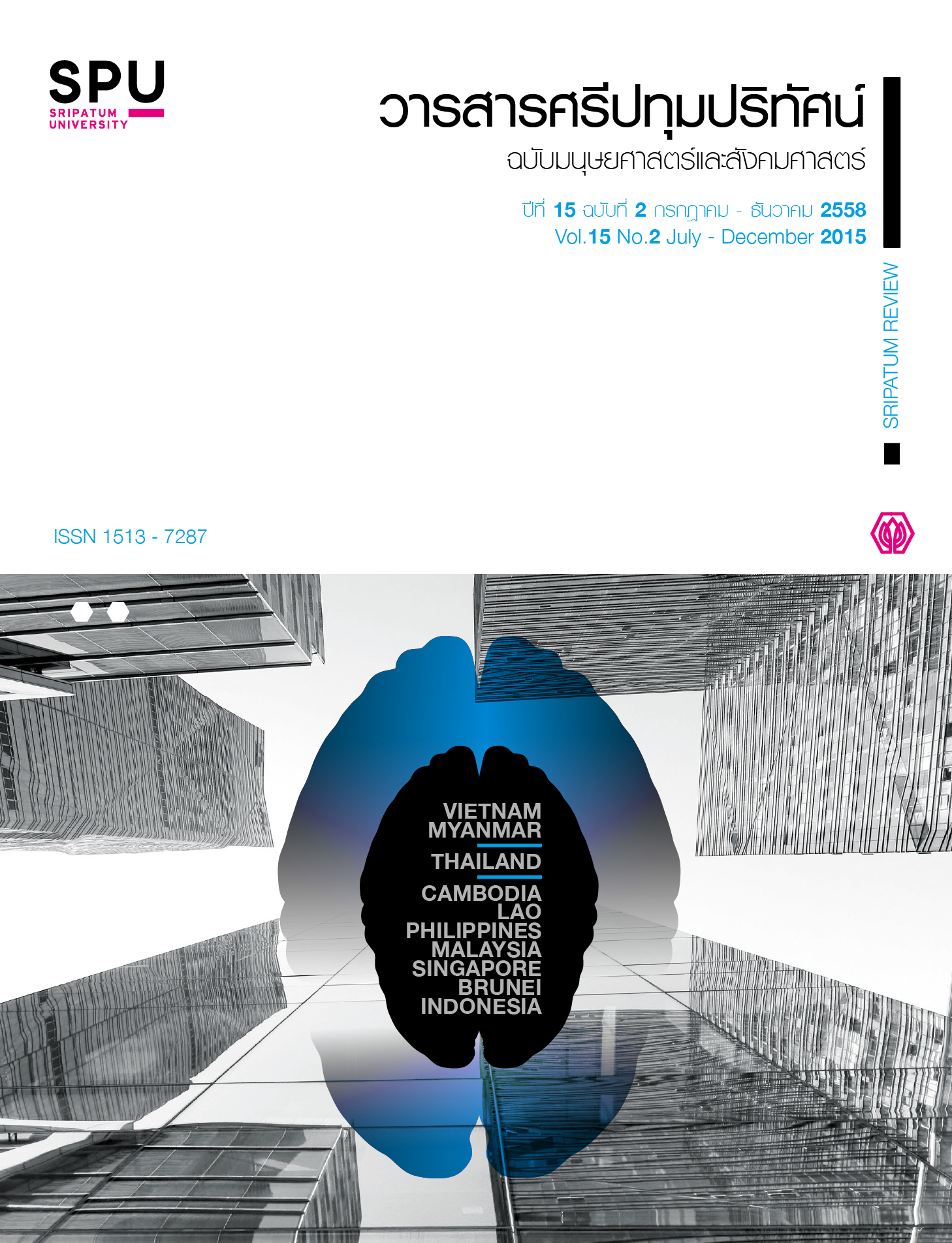A MODEL FOR QUALITY DEVELOPMENT OF SECONDARY SCHOOL BY APPLYING ADMINISTRATIVE INFORMATION TECHNOLOGY
Main Article Content
Abstract
The objectives of this research were (1) to study the state of using information technology for quality development of secondary school; (2) to develop and try out a model for quality development of secondary school by applying administrative information technology; and (3) to study the try-out results of the model for quality development of secondary school by applying administrative information technology. The research sample comprised two groups: (1) a group of 11 purposively selected secondary schools under the Secondary Education Service Area Office 2 in the 2013 academic year; and (2) a group of school personnel consisting of 55 school administrators and 913 teachers and educational personnel from the schools in the first group. The sample size of school personnel in the second group was determined based on Yamane’s Sample Size Table. Three research instruments were employed: (1) a questionnaire on the state and problems of using information technology for quality development of secondary school, (2) an evaluation form to assess the satisfaction with the model for quality development of secondary school by applying administrative information technology, and (3) a survey form on results of internal and external quality assessment of the schools. The data was analyzed by descriptive statistics of frequency, percentage, mean, and standard deviation.
The findings revealed that (1) administrators, teachers and educational personnel perceived that the use of information technology for quality development of secondary school was at the high level in the dimension of personnel administration; while the problem of using information technology for quality development of secondary school was at the high level in the dimension of budget administration; recommendations from the study were that the administrators, teachers, and educational personnel would like to have the program that is systematic, easy to understand, with complete database, with operational manual, with security protection system, and can interact with the users; (2) the model for quality development of secondary school by applying the School ICT Program was composed of 4 programs designed for four groups of administrative work: Group 1: Academic Affairs Administration, Group 2: Budget Administration, Group 3: Personnel Administration, and Group 4: General Administration; and (3) as for try-out results of the model for quality development of secondary school by applying administrative information technology, it was found that the overall mean score from internal quality assessment of the secondary schools was 92.73, which was at the excellent level; while the overall mean score from the third round of external quality assessment of 89.37, which was at the good level; the school administrators, teachers and educational personnel of the schools were satisfied with both the School ICT Program and the model for quality development of secondary school at the highest level; their satisfaction could be ranked from high to low based on rating means as follows: the comprehensiveness and accuracy, the benefits, the suitability and the feasibility of the program. The suggestions were as follows: the program should provide for students to evaluate their teachers; the program should support procurement process; and the program should be able to link the information of students with the data of Personnel Administration Department.
Article Details
1. กองบรรณาธิการสงวนสิทธิ์ในการพิจารณาและตัดสินการตีพิมพ์บทความในวารสาร
2. บทความทุกเรื่องจะได้รับการตรวจสอบทางวิชาการโดยผู้ทรงคุณวุฒิ แต่ข้อความและเนื้อหาในบทความที่ตีพิมพ์เป็นความรับผิดชอบของผู้เขียนแต่เพียงผู้เดียว มิใช่ความคิดเห็นและความรับผิดชอบของมหาวิทยาลัยศรีปทุม
3. การคัดลอกอ้างอิงต้องดำเนินการตามการปฏิบัติในหมู่นักวิชาการโดยทั่วไป และสอดคล้องกับกฎหมายที่เกี่ยวข้อง
References
ปถมภรณ์ สุขสะอาด. 2551. “ปัญหาการใช้ เทคโนโลยีสารสนเทศของผู้บริหารใน การบริหารสถานศึกษาระดับประถมศึกษาในสังกัดสำนักงานเขตพื้นที่การศึกษานนทบุรี เขต 2.”วิทยานิพนธ์ครุศาสตรมหาบัณฑิต สาขาวิชาการบริหารการศึกษา มหาวิทยาลัยราชภัฎจันทรเกษม.
พิมพ์สุจี นวลขวัญ. 2555. “สภาพการใช้เทคโนโลยีสารสนเทศเพื่อการบริหาร ของโรงเรียนในสังกัดสำนักงานเขตพื้นที่การศึกษาประถมศึกษาสงขลา เขต 2.”วิทยานิพนธ์ครุศาสตรมหาบัณฑิต สาขาวิชาการบริหารการ ศึกษามหาวิทยาลัยราชภัฎสงขลา.
พรพัสนันท์ พรพุทธิชัย. 2554. “สภาพการใช้เทคโนโลยีสารสนเทศเพื่อการบริหารของสถานศึกษาขั้นพื้นฐาน ในสังกัดสำนักงานเขตพื้นที่การศึกษาประถมศึกษาสุโขทัย เขต 2. วิทยานิพนธ์ศึกษาศาสตรมหาบัณฑิต สาขาการบริหารการศึกษา มหาวิทยาลัยสุโขทัยธรรมาธิราช.
มนตรี สังข์โต. 2554. “สภาพและปัญหาการใช้คอมพิวเตอร์เพื่อการบริหารงานโรงเรียนมัธยมวัดหนองจอก สังกัดสำนักงานเขตพื้นที่การศึกษามัธยมศึกษา เขต 2.” วิทยานิพนธ์ ศึกษาศาสตรมหาบัณฑิต สาขาวิชา การบริหารการศึกษา มหาวิทยาลัยบูรพา.
สมโพธน์ ชำนาญดี. 2551. “สำนักงานคณะกรรความต้องการของข้าราชการครูที่มีต่อการใช้ เทคโนโลยีสารสนเทศเพื่อการบริหารในโรงเรียนฤทธิยะวรรณาลัย สำนักงานเขตพื้นที่การศึกษากรุงเทพมหานคร เขต 2.” วิทยานิพนธ์ครุศาสตรมหาบัณฑิต สาขาวิชาการบริหารการศึกษา มหาวิทยาลัยราชภัฎพระนคร.
สำนักงานคณะกรรมการการศึกษาแห่งชาติ. 2542. พระราชบัญญัติการศึกษา แห่งชาติ พ.ศ.2542. กรุงเทพฯ: พริกหวานกราฟฟิก.
สำนักงานคณะกรรมการการศึกษาขั้นพื้นฐาน.2554ก. คู่มือการประเมินคุณภาพภายนอกรอบสาม (พ.ศ.2554-2558) ระดับการศึกษาขั้นพื้นฐาน ฉบับสถานศึกษา พ.ศ.2554. กรุงเทพฯ: กระทรวงศึกษาธิการ.
สำนักงานคณะกรรมการการศึกษาขั้นพื้นฐาน. 2554ข. แนวทางการประเมินคุณภาพตามมาตรฐานการศึกษาขั้นพื้นฐานเพื่อการประกันคุณภาพภายในของสถานศึกษา. กรุงเทพฯ: กระทรวงศึกษาธิการ.
สำนักงานคณะกรรมการการศึกษาขั้นพื้นฐาน.2556. แนวทางการจัดการเรียน การสอนในโรงเรียนมาตรฐานสากล ฉบับปรับปรุง. กรุงเทพฯ: พริกหวานกราฟฟิก.
สำนักงานเลขาธิการสภาการศึกษาแห่งชาติ. 2556. พระราชบัญญัติการศึกษา แห่งชาติพ.ศ.2542 (แก้ไขเพิ่มเติมครั้งที่ 2 พ.ศ. 2545). กรุงเทพฯ: พริกหวานกราฟฟิก.
สุริยา ทับน้อย. 2552. “การปฏิบัติการจัดระบบสารสนเทศของโรงเรียนประถมศึกษา สังกัดสำนักงานประถมศึกษา จังหวัดราชบุรี.”วิทยานิพนธ์ศึกษาศาสตรมหาบัณฑิต สาขาวิชาการบริหารการศึกษา มหาวิทยาลัยศรีนครินทรวิโรฒ.
โสภา ตุ้มช้าง. 2550. “ทักษะการบริหารของผู้บริหารที่ส่งผลต่อคุณภาพของ ระบบสารสนเทศของโรงเรียนสังกัด กรุงเทพมหานคร.” วิทยานิพนธ์ ศึกษาศาสตรมหาบัณฑิต สาขาวิชา การบริหารการศึกษา มหาวิทยาลัยศิลปากร.
อภิชิต บุญผ่องศรี. 2554. “สภาพการปฏิบัติ และปัญหาการใช้เทคโนโลยีสารสนเทศเพื่อการบริหารโรงเรียนในอำเภอ ปากชม จังหวัดเลย สังกัดสำนักงานเขตพื้นที่ การศึกษาเลย เขต 1.”วิทยานิพนธ์ศึกษาศาสตรมหาบัณฑิต สาขาวิชาการบริหารการศึกษา มหาวิทยาลัยนอร์ทกรุงเทพ.
Georgie, R. 1999. “Education Chalks up Major Investment Cash.” Retrieved March 15, 2012.
Glenda C. R., Brenda T. G., Thomas A. R. 2006. “Quality Assurance in Teacher Education: Warranty Programs.” National Forum of Teacher Education Journal- Electronic,16, 1-2.
Vicky, P. 1998. "Virtual Classrooms" In Nation's Business. U.S. Chamber of Commerce; Washington, DC 20062-2000.
Yamane, T.1973. “Statistics: An Introductory Analysis.” Third edition.Newyork: Harper and Row Publication.


